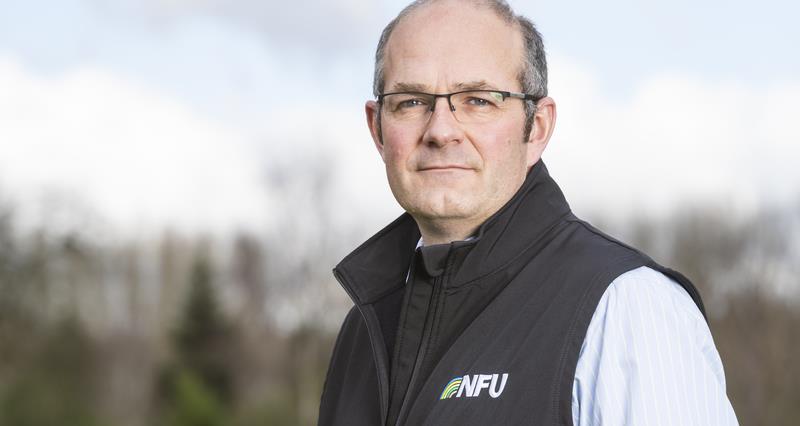Published as part of – which measure the total profit from all UK farming businesses during the past calendar year – this surge translates to an increase of £1.6bn from 2023, giving an overall total income of £7.7bn for the UK.
However, income figures for 2023 have been revised down by over £1bn as fertiliser costs were 72% higher than previously thought, meaning that the increase in 2024 is from a much lower base than previously thought.
“Set against historically low incomes, these modest gains are a step forward, but they are fragile.”
NFU President Tom Bradshaw
Farming’s overall contribution to the UK's economy increased by £1.6bn or 12.8% compared with 2023.
This is in marked contrast to 2023 figures, which found large decreases in crop outputs and delayed purchases of fertiliser had driven a 24% drop in farming profitability in England.
The boost in profits appears to be largely driven by beef and sheep outputs which have increased by 9% and 13% respectively, however, the increase in output prices for this sector was overdue and needed to enable reinvestment following many years of insufficient returns.
Cereals remained on a downward trend, with outputs falling by 22% in 2024 compared to 2023, reflecting the weather challenges faced when planting the 2024 harvested crop and a fall in global prices. This has severely impacted profitability for cereals farmers.
‘Volatile environment’
Responding to the figures, NFU President Tom Bradshaw said the last few years had demonstrated the “significant volatility” seen in recent years, with the new figures hiding this, as well as the “variable returns across different farming sectors”.
The data is “shaped by a complex mix of markets, weather and 2023 having the highest input costs in decades because of the tragic situation in the Ukraine,” Tom said.
“These figures once again show just how exposed farmers across the four countries of the UK are to these pressures”.
“Arable farmers have been hit particularly hard due to falling global prices and extreme weather, and while some sectors like beef and sheep have recovered slightly, it comes after years of unsustainable returns.
“Set against historically low incomes, these modest gains are a step forward, but they are fragile. Without consistent policy support and market stability they won’t last.”
Eggs and dairy recover and inputs decline
Output from dairy farms has also increased in 2024 by 6% on the back of a 2023 which was more challenging for farm profitability, while revenue from egg production has also recovered significantly (+35%) as demand for eggs remains strong.
The total cost of inputs declined in 2024 compared to 2023 by 5%, mainly driven by reductions in expenditure on fertiliser (-26%) and animal feed (-7%).
�ʼһ���President said the decline in input costs was positive, but noted they are still "far above where they were before the global geopolitical shocks we have seen in recent years".
Tom added: “This is why the upcoming Spending Review is so important. Farmers need certainty to plan and invest, and a long-term UK agriculture budget of £5.6bn would help underpin our nature-friendly food production and support rural communities.
“Farmers are resilient and adaptable, but they cannot shoulder all the risk on their own. This is a clear signal that government must step up and put food security at the heart of its priorities.”
Crop and livestock output
According to Defra’s figures the largest contribution to total crop output was wheat with a value of £2,161 million. Wheat also saw the largest value decrease of all crop commodities, falling by £796 million (-26.9%).
The 2024 wheat crop suffered due to wet planting conditions in winter and spring Defra said, with limited yields and variable quality. Prices continued to decrease from spikes seen in 2022 and 2023 as a result of the Ukraine-Russia conflict, with this year's milling wheat prices showing a 9.3% decrease from 2023.
The second largest value decrease was for barley despite an increase in production, with Defra identifying reductions in price as having driven this overall decrease. Oilseed rape saw the largest percentage value decrease driven by a 25% decrease in planted area and production affected by pest pressures and competitive global supplies of soybeans
Elsewhere, milk drove the largest contribution to total livestock output. At the start of 2024, farm-gate milk prices were 17.1% lower than the historically high first-quarter price in 2023, but prices began to increase in spring and into the summer due to reduced global dairy product supply. Increased prices then drove production volume increases in the latter half of the year.
Beef also increased by 9.3% compared to 2023, primarily due to an increase in the deadweight price of prime cattle, reflecting strong consumer demand and an expectation of tighter supplies in 2025.
Costs remain high despite decrease
The largest contribution to intermediate consumption was animal feed, Defra said, contributing a value of £4,415 million.
The value of fertilisers fell by 26.3% driven by a decrease in the cost of gas and a return to regular purchasing patterns after the price volatility of 2022 and 2023.
Overall there was a general decreasing trend across the majority of intermediate consumption items, largely driven by a reduction in the high energy and fuel prices seen in 2022 and 2023.



